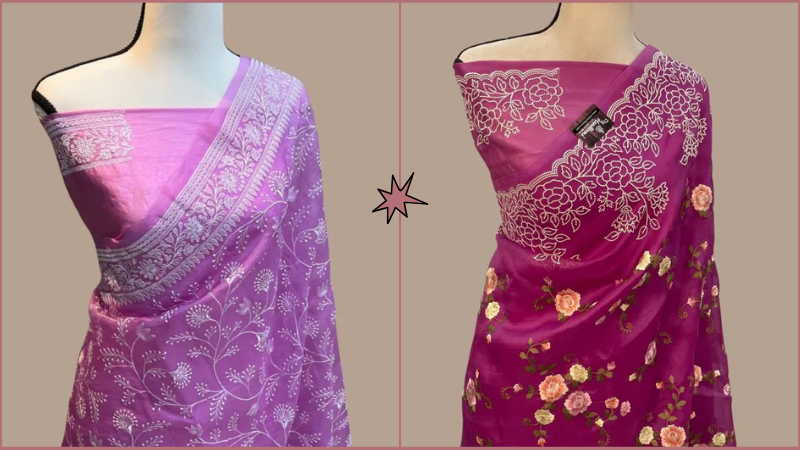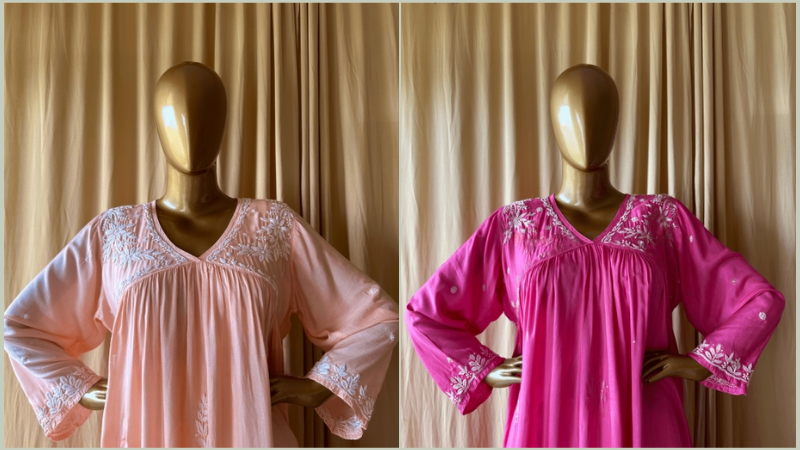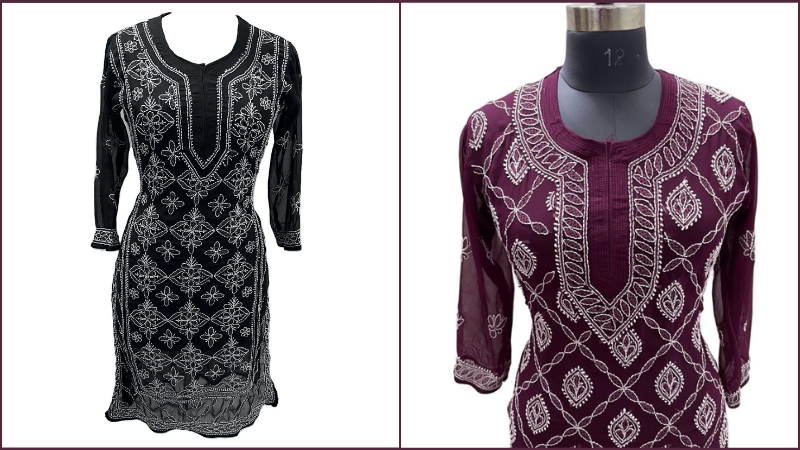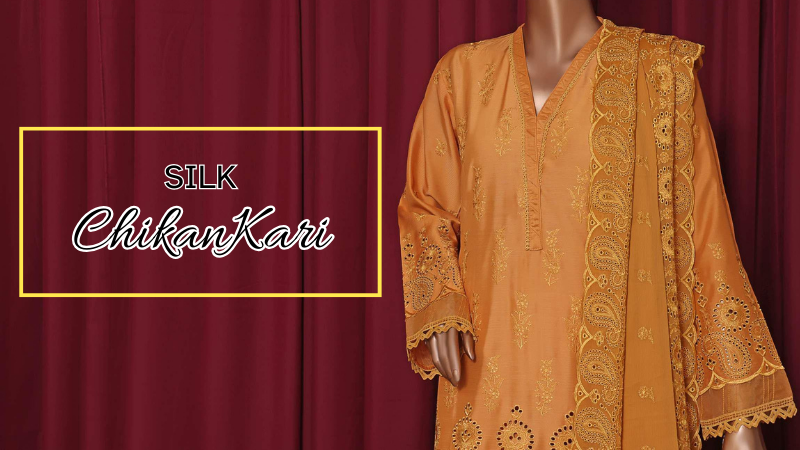Chikankari is a delicate hand embroidery on fabrics like muslin, silk, chiffon, organza, and net. Though it originated as a court craft, it is a practised tradition and an important commercial activity today. White thread is embroidered on excellent, pastel shades of light muslin and cotton garments. Lucknow is the heart of the Chikankari industry. Lucknawi Chikan is the term used to refer to it nowadays.
The fabric typically used in Chikankari embroidery is muslin or cotton. Muslin is a lightweight, sheer, and soft fabric that drapes well and is easy to work with.it is estimated that around 60% of all clothing globally is made from cotton. It is estimated that nearly 90% of garments that feature chickenkari embroidery use cotton as the base fabric. These fabrics are ideal for Chikankari embroidery because they can be easily printed and embroidered upon and are comfortable to wear.
The cloth used for chikankari embroidery is typically washed and treated beforehand to make it feel softer and eliminate any starch or size. Afterwards, the fabric is printed with the design that will be embroidered using a wooden block-printing technique. The embroidery is done with a thin, white cotton thread, and it can take weeks or even months to complete a single garment if done by hand, but the machine will take less time.
Due to its delicate nature, chikankari embroidery is typically done on light-coloured fabrics, such as white or pastel shades. However, some modern designs also use other colours.
In recent years, chikankari embroidery has also been done on other fabrics like silk, georgette, chiffon, and even denim to cater to the demands of modern fashion.
Cotton
When it comes to the use of cotton for chickenkari embroidery, a significant percentage of clothing uses this fabric. The smooth texture and capacity to hold intricate designs make cotton the preferred choice for this embroidery style. The softness and breathability of cotton also make it comfortable to wear, which is necessary for garments like traditional Pakistani kurtas and Kameez, often embroidered with chicken Kari embroidery.

Cotton is preferred for chicken kari embroidery because it absorbs the dye easily, allowing for a wide range of threadwork colours.
Additionally, the strength and durability of cotton make it ideal for the excellent and complex Stitches required for chicken Kari embroidery.
Cotton plays an essential role in the production of clothing with chickenkari embroidery. Its unique properties make it the ideal fabric for this traditional embroidery technique, and its popularity continues to grow as more and more people appreciate the beauty and artistry of chicken Kari embroidery. Whether a traditional Pakistani outfit or a modern fashion piece, cotton remains the top choice for garments featuring this superb embroidery style.
Organza
Organza is a delicate and transparent fabric often used for chickenkari embroidery. This fabric is made from silk, polyester or nylon and is known for its smooth and shiny finish. Due to its transparent nature, it is often used as an overlay or underlay fabric to add texture and dimension to garments. In recent years, there has been a rise in the use of organza for chickenkari embroidery, a popular form of embroidery originating from India. This tricky embroidery technique involves creating lovely patterns and designs using a needle and thread on fabric. The lightweight and sheer nature of the organza makes it the perfect canvas for this type of embroidery, as it allows for the intricate details of the chicken Kari work to stand out.

Additionally, the smooth finish of the organza creates a beautiful contrast with the textured and raised embroidery, creating a stunning visual effect. As a result, more and more clothing designers and manufacturers are incorporating organza into their collections, with a significant percentage of clothes using this fabric for chickenkari embroidery. Organza is a popular fabric for adding elegance and intricacy to garments through chicken Kari embroidery, whether a traditional Pakistani kameez, a modern Western-style dress, or an evening gown. Its versatility and ability to elevate any design make it a favourite among fashion designers and consumers alike, ensuring that the demand for organza for chicken Kari embroidery will continue to rise.
muslin
One particular use for muslin that has gained significant attention in recent years is for chickenkari embroidery. This traditional form of embroidery, originating in the Indian subcontinent, involves intricate designs created with white thread on a white muslin fabric. The delicate and precise nature of chickenkari embroidery requires a lightweight, soft fabric that is easy to work with, making muslin the perfect choice. Additionally, muslin is known for its breathability, making it a comfortable option for clothing items, which is essential in the hot climate of South Asia. This makes it a popular fabric for traditional garments such as Kameez,kurtis, kurtas, and dupattas, often adorned with chickenkari embroidery.

Furthermore, muslin's ability to hold intricate details and its sheer quality make it a demandable fabric for special occasion wear. It is no surprise that a high percentage of clothes that feature chickenkari embroidery are made from muslin. This type of embroidery's delicate and intricate nature requires a fabric that can withstand detailed needlework without losing its shape or compromising the design. Muslin's lightweight and airy nature also allows the embroidery to stand out and be the focal point of the garment. Moreover, muslin is affordable, making it accessible to many consumers, from high-end fashion designers to everyday wear. With its long history and cultural significance in the Indian subcontinent, chickenkari embroidery has become a timeless fashion trend, and muslin's role in this art form remains essential. In conclusion, a significant percentage of clothes featuring chickenkari embroidery use muslin as the fabric of choice, and its popularity is expected to grow.
Velvet
For centuries, velvet has remained a popular fabric known for its luxurious feel and rich appearance. This fabric, made from silk, cotton, or synthetic fibres, has a smooth, soft pile that gives it a unique texture and sheen. In recent years, velvet has become increasingly popular in the fashion industry, and one of its most notable uses is in the art of chickenkari embroidery. Chickenkari, also known as chikankari, is a traditional form of embroidery originating from the Indian state of Lucknow. It involves intricate and delicate hand stitching on various fabrics, including velvet. Velvet is a rich, dense fabric that provides a sturdy base for the delicate threadwork of chicken Kari. The soft and plush nature of velvet allows the thread to glide smoothly, making it easier for the embroiderer to create intricate designs. The contrast between the softness of the velvet and the delicate threadwork creates a beautiful texture unmatched by any other fabric.

It is often used in traditional Pakistani attire, such as Kameez, lehengas, and dupattas. Still, it has also been incorporated into modern Western clothing styles and sometimes into sarees often worn by women at parties and ceremonies. The intricate stitches of chickenkari stand out beautifully against the soft, plush surface of velvet, creating a stunning contrast. This combination of two luxurious fabrics has gained popularity in India and globally. It is estimated that approximately 30% of all clothes that feature chickenkari embroidery use velvet as the base fabric. This percentage is expected to increase as more designers and brands incorporate chickenkari embroidery into their collections. The use of velvet for chickenkari embroidery enhances the overall look and feel of the garment and adds a touch of cultural significance. It is a beautiful representation of the fusion of traditional and modern fashion, making it a sought-after choice for many fashion enthusiasts.
Chiffon
The process of creating chickenkari embroidery on chiffon begins with selecting the fabric. Chiffon is typically made from silk, cotton, or synthetic fibres and comes in various colours and textures. The most commonly used chiffon for chickenkari embroidery is silk chiffon, which has a luxurious and smooth feel, adding to the finished product's overall elegance.

Once the fabric is selected, the design is drawn onto it using a special pen or pencil. This design is then carefully embroidered onto the fabric using a needle and thread. The delicate nature of chiffon requires the embroiderer to have a steady hand and precise movements; one small mistake can ruin the entire piece. The thread used for chicken Kari embroidery is usually silk or cotton. It comes in various colours to create vibrant and eye-catching designs.
silk
Silk is preferred for chickenkari embroidery because of its smooth and lightweight texture. This makes it easier for skilled artisans to embroider the intricate patterns, as the silk fabric provides a smooth and even surface for the needle and thread to glide through.
Silk is also a durable and strong fabric, essential for chickenkari embroidery, as delicate stitches require a sturdy base. This ensures that the embroidery will last for a long time without fraying or tearing, maintaining the beauty of the intricate designs. Additionally, silk is a breathable fabric, making it an ideal choice for South Asia's warm and humid climate, where chickenkari embroidery originated.

In addition, silk is a multipurpose textile in diverse colours and textures, providing numerous possibilities for incorporating chickenkari patterns. Whether for unique and bright tones or delicate and muted hues, silk can be easily dyed in various shades to complement any chosen design and style. The silk finishes, including satin, crepe, and chiffon, enhance the embroidery by introducing dimension and texture, resulting in a more visually attractive piece.
Besides its practical benefits, silk also holds cultural significance in chickenkari embroidery. In South Asia, silk is considered a symbol of wealth and prosperity, and using it in chickenkari embroidery adds a touch of luxury to the garments. This makes it popular for special occasions and traditional ceremonies where chicken Kari embroidered clothes are often worn.
Silk is an integral part of chickenkari embroidery, with a significant percentage of clothes featuring this traditional art form using silk as the fabric of choice. Its smooth surface, durability, breathability, versatility, and cultural significance make it the perfect fabric for this beautiful hand-stitched design of chicken Kari embroidery. From traditional garments to modern fashion, silk remains an essential element in this beautiful form of embroidery.
In Conclusion
Chikankari embroidery is more than just stitching on fabric. It's a story, an emotion, and a proof of the dedication of artisans who have kept this art alive against the tides of time. By understanding the fabrics and materials that form the core of Chikankari, we appreciate artisans' craft and hard work even more. Join Pandi in celebrating this beautiful art form and the talented hands behind it.













